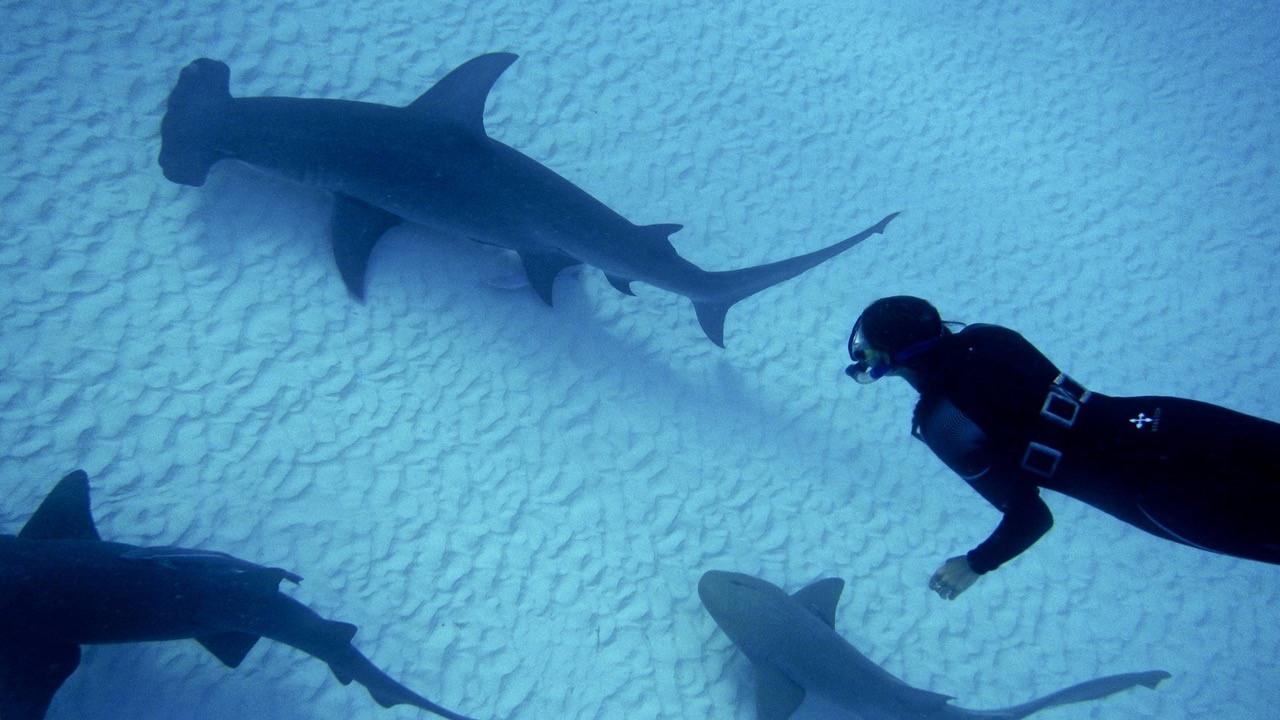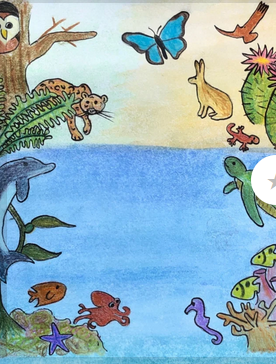
The Science of Ireland’s Sea Monsters: Searching for Sharks with Animal Behavior Graduate Group Student Alexandra McInturf
Quick Summary
- For years, Animal Behavior Graduate Group student Alexandra McInturf has traveled to Ireland to investigate the behaviors of basking sharks
- Though they’re the second-largest fish on the planet, these leviathans are shrouded in mystery
- McInturf hopes to reveal their underwater world through her research on their movements and social behavior
Malin Head is a rugged place. Located at the most northerly tip of Ireland, it’s a place where wind whips at seabirds dotting the sky and where the Atlantic Ocean crashes into cliffs topped with greenery. But below the waves lies the hidden world of a mysterious leviathan: the basking shark (Cetorhinus maximus).
“Basking shark aggregations used to number in the thousands and that’s where they were targeted by fisheries, unfortunately,” said Alexandra McInturf, a Ph.D. candidate in the Animal Behavior Graduate Group.
Throughout the 19th and 20th centuries, humans hunted basking sharks for their oil-rich livers.
“There was a huge demand for them, especially in the Northeast Atlantic,” said McInturf. “For a long time during the World Wars, the streets of Belfast…their lights were fueled by basking shark oil.”
Today, the International Union for Conservation of Nature lists the basking shark as endangered.

The Ethogram
In addition to her research, McInturf is an editor of The Ethogram, the official blog of the UC Davis Animal Behavior Graduate Group. Started in 2015, the blog welcomes submissions from students and researchers of animal behavior at all levels.
For years, McInturf has traveled to Malin Head to investigate the behaviors of basking sharks. Though they’re the second-largest fish on the planet, they remain a mystery. A few of the knowns: they’re large, growing up to 30 feet; they can dive up to 1,000 meters; and they love plankton, spreading their gaping maws to filter-feed. But the unknowns outweigh the knowns.
Why do basking sharks congregate? Do these aggregations serve a social purpose for the species? And if so, what is that social purpose?
McInturf wants to answer these questions. Doing so will not only satiate her sharky curiosity, but it could influence how our species interacts with basking sharks.
“I’m hoping to identify hotspots in Ireland to justify the implementation of Marine Protected Areas and inform their placement,” she said.
The “shark girl”
Raised in landlocked Cincinnati, Ohio, McInturf knew she wanted to study sharks at age 12. She decided this during a family vacation to Florida’s Gulf Coast. During a sunset walk along the beach with her father, McInturf realized something.

“I remember looking out at the water and being like, ‘It’s a little overwhelming how much is in there that you can’t see,’” she said.
The ocean held countless mysteries, mysteries that McInturf wanted to unravel. She asked her father if people studied the ocean. According to McInturf, her father replied, “I think you can. I think it’s called marine biology.”
The Florida visit corresponded to Discovery Channel’s Shark Week.
“I remember watching Shark Week and thinking, ‘That’s terrifying but also really cool,’” said McInturf. “My way to confront fear, I think, is to try to understand where it’s coming from and so to me, it’s very natural for me to try to understand what sharks are doing and to know more about them.”
“I’ve been known as the ‘shark girl’ since like early middle school,” she added.
An obsession was born. McInturf voraciously scarfed down shark literature, building her knowledge base out of pure curiosity. Between semesters studying biology and English at Williams College, located in Williamstown, Mass., she worked at the Newport Aquarium in Kentucky, where she assisted with shark husbandry efforts.
Though the interest was there, McInturf didn’t formalize her shark research until the gap year following her graduation in 2015. She spent the month of July in South Africa’s Mossel Bay, where she studied great white sharks (Carcharodon carcharias) with Oceans Research. She then spent another two months at the Bimini Shark Lab in the Bahamas, where she primarily studied lemon sharks (Negaprion brevirostris), tiger sharks (Galeocerdo cuvier) and great hammerheads (Sphyrna mokarran).
“I love being in the water with them,” said McInturf of sharks. “The way they move is really graceful, especially the hammerheads…They just swim with purpose.”
That’s not to say she hasn’t had a frightful moment. McInturf recalled a time she and the team were barracuda fishing at a common hammerhead site. The sky was getting dark and McInturf was in the water with bait in her hands. She looked ahead and noticed a hammerhead swimming in her direction. It was her first encounter with the species. Cool under pressure, McInturf held the bait out of the water. The shark changed course and cruised beneath her, nudging her dive fin with its body.
“If anything, I’ve always just been kind of shocked with how calm they were,” said McInturf.

Studying with “Dr. Hammerhead”
In fall 2016, McInturf enrolled in the Animal Behavior Graduate Group at UC Davis, attracted to the program by the work of Adjunct Professor of Wildlife, Fish and Conservation Biology Pete Klimley. Klimley was launching a new shark project.
“Pete was known as ‘Dr. Hammerhead’ in the shark world, very famous for his work putting transmitters on sharks,” said McInturf. “He was very, very well-versed in all methods of biotelemetry. He used to build his own transmitters. I had heard his name since I was very young.”
Klimley introduced McInturf to Emmett Johnston, co-founder of the Irish Basking Shark Project. The project aims to expand existing knowledge of basking sharks while promoting sustainable research practices. McInturf’s contributions to the project include research on basking shark movement and social behavior.
“I study basking shark hotspots and these are areas where these animals will come consistently and aggregate,” said McInturf. “Our question is, ‘Why in the world do they do this?’ And more specifically, ‘What do they do when they are in these hotspots that can give us a clue?’”
After Klimley’s retirement, McInturf started working with Assistant Professor Damien Caillaud, Department of Anthropology, and Professor Nann Fangue, Department of Wildlife, Fish and Conservation Biology. Caillaud studies primate movement and social behavior while Fangue studies fish physiology. Combined, their techniques and methods inform McInturf’s research practices on basking shark social behavior.
“I think understanding shark social behavior can be really critical to reversing our cultural perception of mindless, man-eating animals,” said McInturf. “It would indicate that these animals have a higher cognitive ability than we give them credit for.”
To study basking shark social behavior, McInturf must tag individuals with advanced biologgers called “chat tags” that record movement, physiology data and interactions between individuals.
“It’s essentially an animal-borne receiver and transmitter in one, which means that if I put a chat tag on two sharks, the tags can ‘talk’ to each other and I can ‘listen’ for them,” said McInturf. “If one shark has detections from another shark consistently over time and space that could indicate that there’s some kind of preferential association.”
But tagging sharks is easier said than done.

Swimming fishes
Inside a swim tunnel at the UC Davis Center for Aquatic Biology and Aquaculture, a largemouth bass slipped through the water but made no forward progress. It wriggled against a current powered by motors rather than wind. Cameras captured its movements, feeding visuals to researchers in the lab via a computer screen.
“We’re measuring oxygen consumption over time,” explained McInturf. Since fall 2019, McInturf has learned the ropes of “swimming fish” from Ken Zillig, a Ph.D. candidate in the Graduate Group in Ecology. “Every 20 minutes, we increase to a certain increment the velocity at which the fish are swimming. The goal is to exhaust them but also to reach the area where they’re consuming the most oxygen.”

Why would scientists want to exhaust a fish? It all has to do with predator-prey interactions.
In the wild, bass prey on juvenile Chinook salmon, an at-risk species. These two fish thrive best at different temperatures.
“Bass are warm water predators and so the thinking is that if we put them in a warm water setting, they’re going to be more voracious, they’re going to be able to turn faster, swim faster, burst faster, just be better predators,” said McInturf. “Salmon will be…thermally disadvantaged at warmer temperatures because they’re cold-water fish, so theoretically their bodies have evolved to operate better at colder temperatures.”
In addition to investigating the aerobic and anaerobic capacity of bass and Chinook salmon at different temperatures, McInturf and Zillig will see if this theory holds water by observing the fish in mesocosms, experimental systems that mimic natural environments.
To measure and record movements in a mesocosm, McInturf and Zillig will attach biologgers, or accelerometers, to the fish. The biologgers measure movement in three dimensions, which will allow McInturf and Zillig to record physiological signatures related to movement behaviors like hunting or evasion. McInturf described biologgers as “animal Fitbits” that can log new data up to 100 times per second.
“We velcro the biologgers to plates on the bass’ backs and then we take them off again, so it’s much easier obviously in a captive setting to use them,” said McInturf, who normally attempts to deploy biologgers in much wilder conditions and on much bigger predators.
After discussing her research on bass-salmon interactions, McInturf fetched a padded box of gear from the corner of the facility.
“This is the box I take to Ireland every summer,” she said, opening it to reveal coiled cords, a fish-borne camera and a handful of yellow tags. Blazoned on each numbered tag were the words, “PLEASE REPORT TO: IRISH BASKING SHARK PROJECT.”
“Basking sharks,” McInturf said with a sigh. “I love and hate them right now.”

Tagging sharks
Despite seasons spent in the field, McInturf hasn’t tagged a basking shark. That’s not for lack of trying. She’s spent numerous hours on dinghies being whipped to and fro by the waves just waiting for the right moment to deploy a tag. Simply put, the basking sharks have been finicky.
McInturf has high hopes for April 2020. She’s found a new field site: Achill Island, which is located on Ireland’s west coast. According to McInturf, it “was once the world’s largest basking shark fishery.”
“There’s a current hypothesis that the sharks migrate up along the western coast of Ireland in the spring and then come down to Malin Head in the summer,” she said. “I have not been seeing them in the summer.”
Though basking sharks have evaded McInturf’s grasp, she’s caught glimpses of them from afar. During her first fieldwork season in Ireland, she saw roughly 30 of them breach towards the end of a research expedition. During the ride back to land, McInturf’s colleagues pointed out at the water, claiming to see basking sharks breach in the distance. McInturf, distracted by driving the boat, took to calling the sharks “leprechaun sharks” because she couldn’t see them. Eventually, they puttered to a stop, so McInturf could get a glimpse.
“They look like very awkward whales,” said McInturf, who noted the reason for their breaching behavior is unknown but one theory is that it could be a dominance display.
“We stayed out there until dusk,” she added. “It was perfect.”

